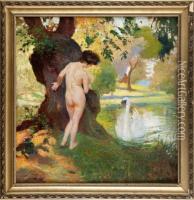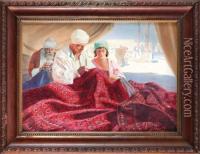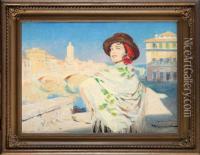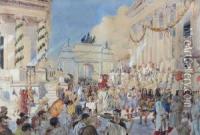Feliks M. Wygrzywalski Paintings
Feliks Michał Wygrzywalski was a Polish painter known for his unique style that combined elements of Orientalism with a fascination for the exotic and the landscapes of North Africa and the Middle East. Born on December 15, 1875, in Berezhany, then part of the Austro-Hungarian Empire (now in Ukraine), Wygrzywalski demonstrated an early talent for the arts, which led him to pursue formal education in the field.
After initial studies in Kraków, Wygrzywalski continued his education at the Academy of Fine Arts in Munich, a center for aspiring artists from across Europe at the time. His travels profoundly influenced his artistic direction, especially his trips to Egypt, Tunisia, and other parts of North Africa, where he was captivated by the light, color, and daily life of these regions. This experience steered his work towards Orientalism, a popular genre among European artists in the 19th and early 20th centuries, characterized by its romanticized depictions of the 'Orient.'
Wygrzywalski's oeuvre primarily includes landscapes, scenes of daily life, and portraits imbued with a sense of realism and attention to detail. His work is noted for its vibrant colors, intricate compositions, and the ability to convey the atmosphere of the places he depicted. Despite his focus on exotic locales, Wygrzywalski's art also reflects a deep personal connection to his homeland, with some works depicting Polish themes and landscapes.
Throughout his career, Wygrzywalski participated in numerous exhibitions in Poland and abroad, gaining recognition and accolades for his contributions to the art world. His paintings can be found in various museums and private collections worldwide. Despite the challenges of World War II and the changing art scene of the early 20th century, he continued to paint until his death on January 29, 1944, in Poznań, Poland.
Feliks Michał Wygrzywalski's legacy as an artist lies in his ability to blend his fascination with the exotic and the familiar, creating a bridge between distant cultures and his own Polish heritage through his art. His work remains a testament to the allure of the Orient as seen through European eyes, as well as a valuable part of Poland's cultural history.

















